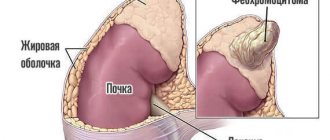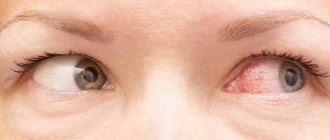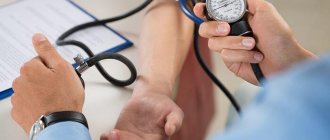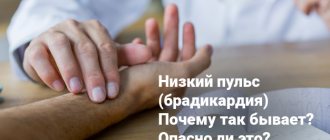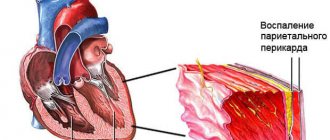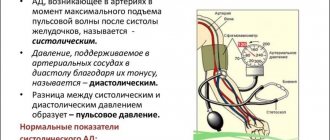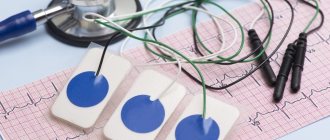Low blood pressure and low pulse are not so uncommon. The development of this condition can be due to reasons of both physiological and pathological nature. When severe hypotension (low blood pressure) and bradycardia (low heart rate) are combined, the blood supply to organs and tissues deteriorates, which leads to the development of hypoxia, hypoxemia, and ischemia. In turn, these disorders can cause serious illness and even death. Therefore, it is important to know what to do if you have low blood pressure and low heart rate.
If the blood pressure is low and the pulse is low, the patient is given an ECG.
Blood pressure and pulse
Blood pressure (BP) is the force with which blood acts on the walls of the arteries. This is one of the important indicators of hemodynamics.
The pulse is the jerky vibrations of the artery walls caused by the movement of blood pushed out by the heart. Typically, pulse examination is carried out on the radial artery, but other superficial arteries (temporal, carotid, femoral) are also excellent for this purpose.
If the pulse rate drops to 40 beats per minute or less, then an ambulance should be urgently called to the patient.
Normally, an adult's heart rate ranges from 60 to 90 beats per minute. A pulse of less than 60 beats per minute is called bradycardia, and its decrease to 50 beats per minute or less poses a threat to human life and health.
Normal daily blood pressure readings are:
- systolic (upper, cardiac) pressure – 91–139 mm Hg. Art.;
- diastolic (lower, renal) – 61–89 mm Hg. Art.
Low blood pressure is called hypotension.
Table of indicators by age
| Age | Minimum heart rate | Maximum heart rate | Norm |
| 1 month-1 year | 102 | 162 | 132 |
| 1-2 years | 94 | 155 | 124 |
| 4-6 | 86 | 126 | 106 |
| 6-8 | 78 | 118 | 98 |
| 8-10 | 68 | 108 | 88 |
| 10-12 | 60 | 100 | 80 |
| 12-15 | 55 | 95 | 75 |
| 15-50 | 60 | 80 | 70 |
| 50-60 | 65 | 85 | 75 |
| 60-80 | 70 | 90 | 80 |
| Age | Minimum pressure mm Hg. Art. | Normal pressure mm Hg. Art. | Maximum pressure mmHg. Art. |
| 1-5 | 80/55 | 95/65 | 110/79 |
| 6-13 | 90/60 | 105/70 | 115/80 |
| 14-19 | 105/73 | 117/77 | 120/81 |
| 20-24 | 108/75 | 120/79 | 132/83 |
| 25-29 | 109/76 | 121/80 | 133/84 |
| 30-34 | 110/77 | 122/81 | 134/85 |
| 35-39 | 11/78 | 123/82 | 135/86 |
| 40-44 | 112/79 | 125/83 | 137/87 |
| 45-49 | 115/80 | 127/84 | 139/88 |
| 50-54 | 116/81 | 129/85 | 142/89 |
| 55-59 | 118/82 | 131/86 | 144/90 |
| 60-90 | 121/83 | 134/87 | 147/91 |
Low blood pressure and low pulse: causes
The combination of hypotension and bradycardia may not be associated with any diseases, but caused by physiological factors.
- Hypothermia. Low temperature reduces the need of tissues for oxygen and nutrients, so the heart begins to work less intensely, which leads to a decrease in blood pressure and a decrease in heart rate.
- Pregnancy. In the third trimester of pregnancy, the fetus begins to compress the inferior vena cava. As a result, blood flow to the heart decreases, which in turn causes a decrease in cardiac output. Clinically, this leads to a sharp drop in pressure and bradycardia.
- Professional sports. In well-trained people at rest, there is a decrease in breathing rate, heart rate, and blood pressure, which is a variant of the physiological norm.
Why is low blood pressure with low heart rate a deviation? The reasons are as follows:
- coronary heart disease (angina pectoris, myocardial infarction, post-infarction cardiosclerosis);
- atherosclerosis of the coronary arteries;
- weakness of the sinus node;
- congenital anomalies of the anatomical structure of the heart.
When severe hypotension and bradycardia are combined, the blood supply to organs and tissues deteriorates in a person, which leads to the development of hypoxia, hypoxemia, and ischemia.
What does a sharp decrease in blood pressure and a drop in heart rate indicate? This is usually observed against the background of critical, life-threatening sick conditions:
- thromboembolism of the pulmonary artery or its major branches (PE);
- collapse or fainting;
- some acute poisonings;
- severe infectious diseases;
- generalized allergic reactions;
- heart rhythm disturbances;
- acute myocardial infarction.
Causes
Tachycardia with hypotension can occur under the influence of various factors. The most common reasons include:
- significant blood loss,
- shock resulting from an allergic reaction, injury, toxins and infections,
- vegetative-vascular dystonia, which occurs with the development of specific crises,
- pregnancy - during pregnancy, vascular tone decreases in a woman’s body due to the influence of the hormone progesterone,
- dehydration resulting from prolonged vomiting and diarrhea, significant physical exertion, heat stroke,
- acute inflammatory processes in internal organs, leading to changes in blood distribution,
- heart damage with changes in myocardial contractility,
- taking certain medications,
- systemic consumption of alcoholic beverages,
- atherosclerosis, which causes blockage of blood vessels,
- diabetes,
- severe vitamin deficiency.
Before starting treatment for tachycardia with hypotension, it is necessary to accurately establish and eliminate its cause. In this case, therapy will bring the desired result much faster.
What are the dangers of a weak pulse and low blood pressure?
If a person has a pulse of less than 50 beats per minute, this should be a reason for a medical examination. To confirm bradycardia, an ECG must be recorded.
If the pulse rate drops to 40 beats per minute or less, then an ambulance should be urgently called to the patient, since this condition can be accompanied by extremely dangerous pathologies:
- atrial fibrillation;
- pulmonary embolism;
- myocardial infarction.
Let's look at what a small pulse and low blood pressure can lead to. A pronounced decrease in heart rate is accompanied by the development of hypoxia, which is manifested by the following symptoms:
- increased fatigue;
- general weakness;
- dizziness and headache;
- fainting conditions;
- severe drowsiness during the daytime;
- pain in the chest area;
- dyspnea;
- cold sweat;
- the appearance of swelling of soft tissues.
First aid
The algorithm of action for low pulse and blood pressure is largely determined by how severe these symptoms are.
A pulse of less than 60 beats per minute is called bradycardia, and its decrease to 50 beats per minute or less poses a threat to human life and health.
With minor bradycardia, hypotensive patients can be advised to drink a cup of strong, sweet tea or coffee. These drinks contain caffeine, which increases vascular tone and increases heart rate.
For mild bradycardia and hypotension, some folk remedies (tincture of Eleutherococcus, ginseng or belladonna) also have a good effect.
If prescribed by a doctor, you can take medications containing caffeine (Citramon, Askofen) at home.
If there is a sharp drop in pulse and blood pressure, the patient needs urgent hospitalization. In order to restore his heart rhythm, he is given injections of Atropine sulfate, Alupent, and Izadrina.
How to treat?
The treatment regimen is prescribed based on the symptoms that the patient has, as well as his age and the cause of the pathology. In most cases, bradycardia with hypotension is treated with drugs from the following groups:
- adaptogens - tincture of lemongrass and ginseng;
- cerebroprotectors - Cinnarizine and Actovegin;
- adrenergic agonists - Ephedrine and Caffeine;
- nootropic drugs - Glycine, Pirocetam;
- antioxidants and antidepressants.
The dosage and duration of administration are determined individually by the doctor.
If treatment with medications does not bring results, surgery may be prescribed to stabilize the heart, which involves installing a pacemaker.
Folk remedies
For low heart rates, traditional healers recommend making a decoction based on onion peels. The product improves vascular tone and accelerates the work of the heart muscle. The husk is brewed for 10 minutes and a spoonful of honey is added. Drink three glasses a day.
At home, you can increase your pulse and blood pressure with lemon. It inhibits age-related changes and is able to restore strength when the body is exhausted and after physical work. It is enough to eat half a lemon every day for a week to improve your well-being and increase your blood pressure.
Teas based on plants such as ginseng, licorice root, calamus, eleutherococcus and radiola rosea have a good effect on the functioning of the heart muscle. Herbs can be used individually or combined with each other. To prepare a decoction, simply boil the dry herb and leave in a thermos for 10 minutes. Drink 2-3 glasses throughout the day.
Nutrition
For bradycardia and low blood pressure, patients are advised to eat high-calorie, easily digestible foods. Be sure to replenish your menu:
- nuts;
- seaweed;
- seafood;
- dried fruits;
- fresh vegetables.
Try to eat small meals 6 times a day. Baked goods, animal fats, marinades and smoked foods should be excluded from the diet. These products clog blood vessels and slow down blood circulation.
Maintain drinking regime. It is very useful for hypotensive patients to drink 2-2.5 liters of liquid a day.
Surgical treatment of bradycardia
If conservative treatment in elderly and young people does not lead to an improvement in hemodynamic parameters, then indications for installing a pacemaker arise.
The pulse is usually measured on the radial artery, although it can be on any large, superficially located
Folk remedies
In consultation with the attending physician, therapy for hypotension and bradycardia can be supplemented with herbal medicine. Most often, experts recommend:
- A decoction of St. John's wort, hawthorn and rosehip fruits, and rosea radiola root. The listed plants are mixed in a ratio of 1:1.5:2:2. Three tablespoons of the resulting mixture are poured with two glasses of boiling water and left for 30-40 minutes. Strain and use half a glass 3 times a day.
- Tincture of ginseng root. To prepare it, you need to grind 25 g of ginseng root and pour one liter of good vodka into it. Leave in a dark place for 21 days. Strain. Take 15-20 drops three times a day half an hour before meals. The course of treatment is 2 months.
- A mixture of walnuts and lemon. Grind half a kilo of walnuts and 4 large lemons through a meat grinder. Add 20 g of granulated sugar, 250 ml of sesame oil and one liter of warm boiled water to the resulting mixture. Mix everything well and store in a well-closed container in the refrigerator. Take a tablespoon three times a day.
If a person has a pulse of less than 50 beats per minute, this should be a reason for a medical examination.
Prevention
To reduce the risk of cardiovascular disease, it is necessary to lead a healthy lifestyle from a young age, which means:
- rejection of bad habits;
- playing sports;
- proper balanced nutrition;
- adherence to daily routine;
- avoidance of stressful situations.
In conclusion, I would like to emphasize once again that bradycardia and hypotension do not always mean disease. But regardless of this, their appearance requires examination of the patient in order to establish the cause.
Diagnostics
Bradycardia and hypotension individually are serious diseases, and if they are combined, the threat to the patient’s life increases several times. It is very important to undergo a medical examination so that the doctor can determine the cause of the pathological condition. As a rule, the list of necessary diagnostic procedures includes:
- electrocardiography;
- Echo-CG;
- Ultrasound of internal organs;
- chest x-ray;
- coronary angiography;
- tests of blood and other biological fluids.
As an addition, a consultation with a nephrologist, endocrinologist and cardiologist may be prescribed.
To diagnose hypotension, the patient's blood pressure is measured regularly over a month. To determine bradycardia, heart rate is measured in a calm and active state.
